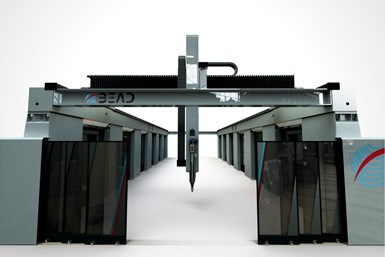Siemens Automation Supports CEAD, Belotti Large-Format Hybrid Machine
The machines will be equipped with Siemens Sinumerik CNC for precise printing and milling.

The Bead hybrid machine requires less space and programming than two separate systems.
CEAD and Belotti have partnered to develop the Bead hybrid machine, which combines large-scale additive and subtractive manufacturing in one solution. The machine will be equipped with Siemens’ Sinumerik CNC automation system for precise printing and milling. The hybrid machine is designed to offer manufacturers lower overall investment, less space and programming, and reduced handling and work-in-process.
By itself, large-scale additive manufacturing (AM) cannot deliver the finish and tolerances that subtractive manufacturing offers, the companies say. On the other hand, subtractive manufacturing can be accompanied by a lot of waste, while large-scale AM is not. Combining these processes gives the best of both worlds: making it possible to 3D print the near-net shape of a part and afterward milling it to the required tolerances with a CNC milling machine.
CEAD and Belotti have taken the combination of these two processes one step further by developing a hybrid machine that requires less space and programming. Also, because the produced parts do not have to be moved between machines, handling time and work-in-process is reduced. Numerous configurations are possible, varying in build volume, output, spindles, position of the heads and more, according to the companies.
All machines will be equipped with Siemens Sinumerik CNC automation systems, for a productive automation solution across all production domains. Depending on the chosen configuration, its CNC performance enables up to 93 axes in 30 machining channels to be controlled in the NCU link. Machine concepts with fewer axes benefit from the performance of the Sinumerik because it offers a high degree of machining precision with the shortest machining times. Based on the system openness of Sinumerik, operation can be supplemented and adapted, which makes it well suited for the hybrid machine.
Related Content
-
Video: For 3D Printed Aircraft Structure, Machining Aids Fatigue Strength
Machining is a valuable complement to directed energy deposition, says Big Metal Additive. Topology-optimized aircraft parts illustrate the improvement in part performance from machining as the part is being built.
-
5 Points You Might Not Know About Hybrid CNC Machine Tools
Hybrid Manufacturing Technologies’ co-founder describes the role of hybrid additive manufacturing machines, and explores their possibilities related to heat treating, multimaterial tooling and making parts with embedding sensing.
-
New Equipment, Additive Manufacturing for Casting Replacement and AM's Next Phase at IMTS 2024: AM Radio #54
Additive manufacturing’s presence at IMTS – The International Manufacturing Technology Show revealed trends in technology as well as how 3D printing is being applied today and where it will be tomorrow. Peter Zelinski and I share observations from the show on this episode of AM Radio.










